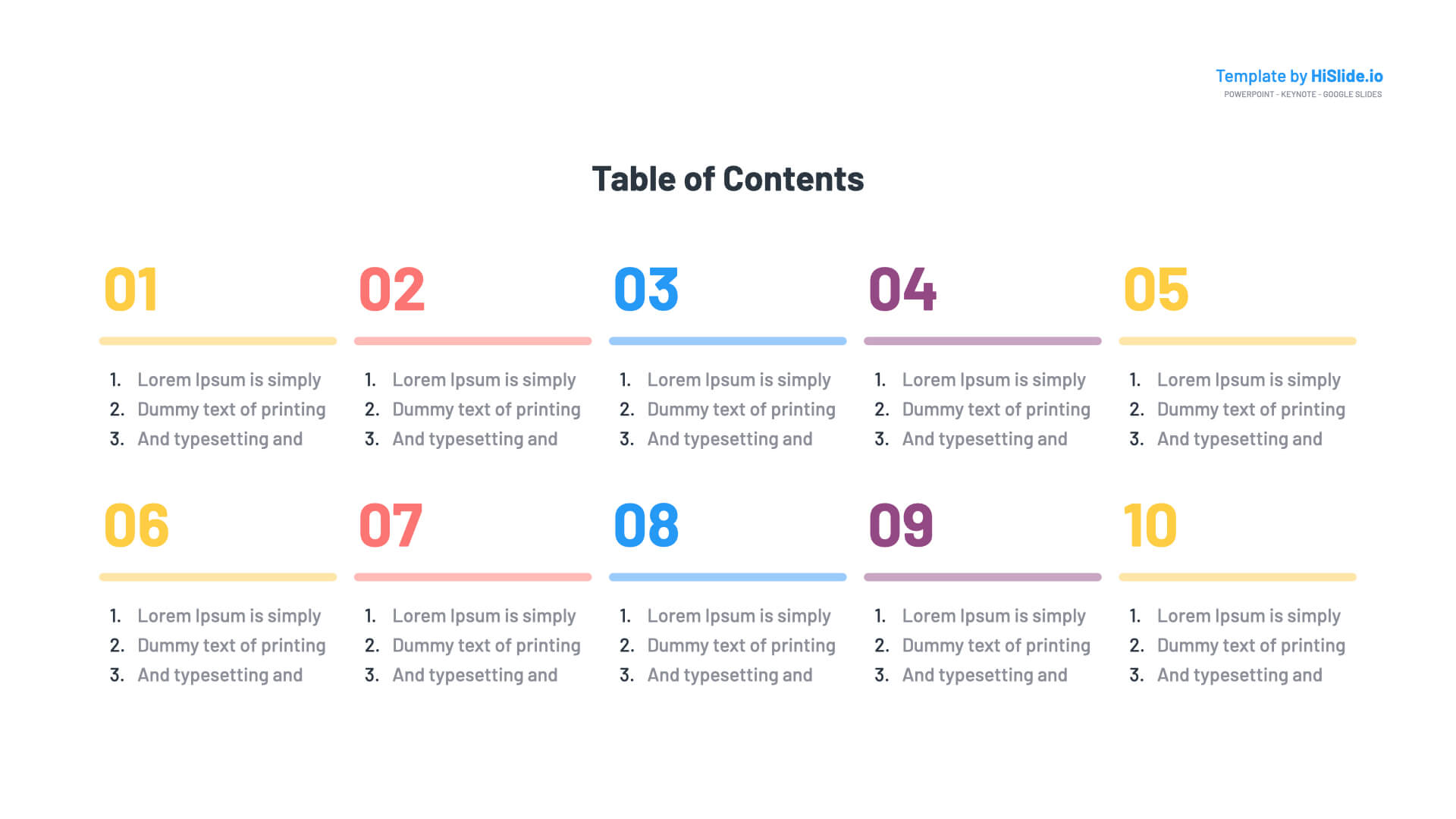In today's fast-paced world, attention spans are shorter than ever. When it comes to delivering a PowerPoint presentation, it is crucial to capture and maintain the audience's attention. One effective way to do this is by incorporating a table of contents https://hislide.io/table-content/ into your presentation. A table of contents serves as a roadmap for your audience, allowing them to easily navigate through the different sections of your presentation. It not only helps them understand the structure of your presentation but also saves time for both the presenter and the audience.
What is a Table of Contents and How Does it Work?
A table of contents is a list of the main sections or topics covered in a presentation, along with their corresponding page numbers or slide numbers. It provides an overview of the content and allows the audience to quickly jump to specific sections that interest them. In a PowerPoint presentation, the table of contents is typically placed at the beginning or end of the presentation, depending on personal preference.

To create a table of contents in PowerPoint, you can manually type out the sections and their corresponding slide numbers, or you can use the built-in feature that automatically generates a table of contents based on the slide titles. This feature can be found under the "Insert" tab, where you can select "Table of Contents" and choose from various formatting options.
Benefits of Using a Table of Contents in Your PowerPoint Presentation
1. Helps the audience understand the structure of the presentation: A table of contents provides a clear overview of the topics that will be covered in your presentation. This helps the audience understand how the information is organized and allows them to mentally prepare for what is to come. It also helps them follow along more easily, as they can anticipate when certain topics will be discussed.

2. Saves time for the presenter and the audience: By including a table of contents in your presentation, you save time for both yourself and your audience. Instead of having to scroll through slides or flip through pages to find a specific section, the audience can simply refer to the table of contents and jump directly to the desired section. This not only makes the presentation more efficient but also keeps the audience engaged by minimizing downtime.
3. Makes the presentation more organized and professional: A table of contents adds a level of professionalism to your presentation. It shows that you have put thought into the structure and organization of your content. It also helps you stay on track during your presentation, as you can easily refer back to the table of contents to ensure that you cover all the necessary topics. Overall, a well-designed table of contents enhances the overall flow and professionalism of your presentation.
How to Create an Effective Table of Contents for Your Presentation
1. Steps to create a table of contents in PowerPoint: To create a table of contents in PowerPoint, follow these steps:

- Decide where you want to place the table of contents (at the beginning or end of the presentation).
- Manually type out the sections or topics covered in your presentation, along with their corresponding slide numbers.
- Format the text to make it stand out, such as using bold or a larger font size.
- If you prefer an automated table of contents, go to the "Insert" tab, select "Table of Contents," and choose from the available options.
- Customize the formatting of the table of contents to match your presentation's design.
2. Choosing the right format for your presentation: When creating a table of contents, it is important to choose a format that is visually appealing and easy to read. Consider using bullet points or numbering to clearly separate each section. You can also use different font styles or colors to make certain sections stand out. Experiment with different formats until you find one that best suits your presentation's style and content.
3. Adding hyperlinks to the table of contents: To make your table of contents interactive, you can add hyperlinks to each section. This allows the audience to click on a specific section in the table of contents and be taken directly to the corresponding slide. To add hyperlinks, select the text in the table of contents, right-click, and choose "Hyperlink." Then, select the slide you want to link to from the list of available slides.
Best Practices for Designing a Table of Contents in PowerPoint
1. Choosing the right font and color scheme: When designing your table of contents, it is important to choose a font that is easy to read and matches the overall design of your presentation. Avoid using overly decorative or hard-to-read fonts. Stick to a consistent color scheme that complements your presentation's theme. Use contrasting colors for the text and background to ensure readability.

2. Keeping it simple and easy to read: A table of contents should be clear and concise. Avoid cluttering it with unnecessary information or excessive details. Stick to the main sections or topics and keep the descriptions brief. Use bullet points or numbering to make it easier for the audience to scan through the content.
3. Using visuals to enhance the table of contents: Consider incorporating visuals, such as icons or images, into your table of contents to make it more visually appealing. This can help break up the text and make it easier for the audience to navigate through the content. However, be mindful not to overload the table of contents with too many visuals, as it may distract from its main purpose.
Tips for Organizing Your Presentation Content with a Table of Contents
1. Grouping related topics together: When creating your table of contents, group related topics together to create a logical flow in your presentation. This helps the audience understand how different sections are connected and allows them to follow along more easily.
2. Using subheadings to break down the content: If your presentation covers a wide range of topics, consider using subheadings within each section to further break down the content. This helps the audience navigate through the presentation and find specific information more quickly.
3. Keeping the table of contents up-to-date: As you make changes to your presentation, make sure to update the table of contents accordingly. This ensures that the audience has access to the most accurate and current information. It also shows that you are organized and attentive to detail.

Examples of Successful Presentations that Utilize a Table of Contents
1. Real-life examples of presentations with effective table of contents: Many successful presenters use a table of contents to enhance their presentations. For example, in a business presentation, a table of contents can help the audience understand the different sections, such as market analysis, product overview, and financial projections. In an educational presentation, a table of contents can provide an overview of the lesson plan or curriculum covered.
2. How they helped the presenter and the audience: By using a table of contents, presenters can deliver their content in a more organized and structured manner. It helps them stay on track and ensures that they cover all the necessary topics. For the audience, a table of contents makes it easier to follow along and find specific information. It saves them time by allowing them to jump directly to sections that interest them.
Common Mistakes to Avoid When Using a Table of Contents in PowerPoint
1. Overcomplicating the table of contents: Avoid overcomplicating your table of contents with too many sections or subheadings. Keep it simple and focused on the main topics or sections covered in your presentation.
2. Not updating the table of contents: It is important to keep your table of contents up-to-date as you make changes to your presentation. Failing to do so can confuse the audience and make it difficult for them to find the information they need.
3. Using too many subheadings: While subheadings can be useful for breaking down the content, using too many can overwhelm the audience. Stick to a reasonable number of subheadings and ensure that they are clear and concise.
Updating Your Table of Contents: When and How to Do It
1. When to update the table of contents: It is important to update your table of contents whenever you make significant changes to your presentation. This includes adding or removing sections, reordering slides, or making substantial edits to the content. It is also a good practice to review and update the table of contents before each presentation to ensure its accuracy.
2. How to update the table of contents: To update the table of contents in PowerPoint, you can either manually edit the text or use the built-in feature that automatically generates a table of contents based on the slide titles. If you choose to manually edit the text, make sure to update the slide numbers or page numbers accordingly. If you prefer an automated table of contents, simply select the table of contents and click on the "Update Table" button under the "Table of Contents" tab.
Conclusion: Why a Table of Contents is the Secret Weapon for a Professional PowerPoint Presentation
In conclusion, a table of contents is an essential tool for creating a professional and effective PowerPoint presentation. It helps the audience understand the structure of your presentation, saves time for both the presenter and the audience, and enhances the overall organization and professionalism of your content. By following best practices for designing and organizing your table of contents, you can create a visually appealing and user-friendly roadmap for your audience. So next time you prepare a PowerPoint presentation, don't forget to include a table of contents - it may just be your secret weapon for success. |




